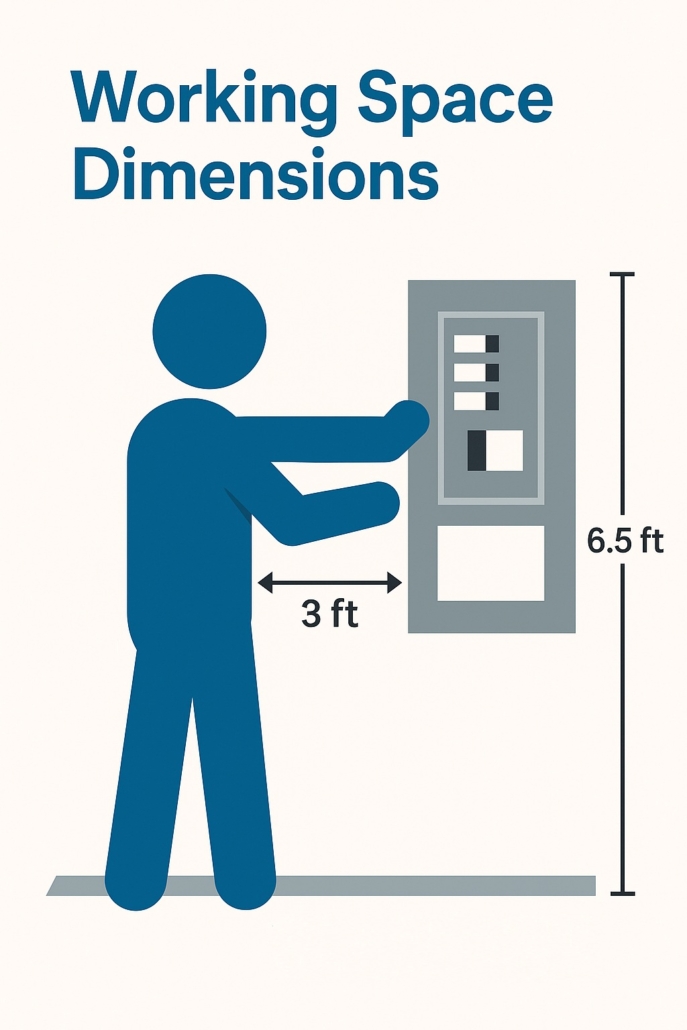
Reference: Working space per 110.26 NEC 2023
In electrical design and installation, maintaining safe working clearances is not optional—it’s essential. The 2023 National Electrical Code (NEC), specifically Article 110.26, outlines critical requirements for the working space around electrical equipment, ensuring personnel safety, accessibility, and code compliance.
Let’s explore what’s new, what’s important, and how to ensure compliance in your projects.
🔧 What is Article 110.26?
NEC 110.26 governs the minimum space required around electrical equipment likely to require examination, adjustment, servicing, or maintenance while energized. This includes panelboards, switchgear, motor control centers, disconnects, and similar equipment.
📏 Working Space Dimensions
1. Depth of Working Space (110.26(A)(1))
The required depth depends on voltage and installation condition:
| Voltage to Ground | Condition 1 | Condition 2 | Condition 3 |
|---|---|---|---|
| 0 – 150V | 3 ft | 3 ft | 3 ft |
| 151 – 600V | 3 ft | 3.5 ft | 4 ft |
| 601 – 1000V | 3 ft | 4 ft | 5 ft |
-
Condition 1: Exposed live parts on one side, no live or grounded parts on the other.
-
Condition 2: Exposed live parts on one side, grounded parts (such as concrete or brick) on the other.
-
Condition 3: Exposed live parts on both sides.
📌 Note: The depth must be measured from the front of the enclosure, not from the live parts inside.
2. Width of Working Space (110.26(A)(2))
-
Minimum: 30 inches or the width of the equipment, whichever is greater.
-
The space can be centered or offset and may overlap adjacent equipment’s working space.
3. Height of Working Space (110.26(A)(3))
-
Minimum: 6.5 feet (6 ft 6 in) or the height of the equipment, whichever is greater.
-
Must allow doors to open at least 90 degrees.
4. Surface Requirements (110.26(A)(6))
-
The floor or platform of the working space must be level and as flat as practical across the required depth and width.
🚪 Access and Egress Requirements
Minimum Entrance to Working Space (110.26(C)(1))
-
At least one entrance must be provided.
-
The minimum clear opening must be 24 inches wide and 6.5 feet high to allow safe access and exit—even when equipment doors are open.
Equipment Doors Must Not Obstruct Egress (110.26(A)(4))
-
Open doors must not reduce the egress path below 24 inches wide or 6.5 feet high.
-
If they do, the layout must be adjusted to eliminate this obstruction.
Large Equipment Requirements (110.26(C)(2))
-
For equipment rated 1200A or more and over 6 feet wide, two means of egress are required—each with a minimum of 24 inches width and 6.5 feet height.
🔒 Dedicated Equipment Space (110.26(E))
-
Equipment such as switchboards, panelboards, and service disconnects must have dedicated space extending 6 feet above the equipment or to the structural ceiling, whichever is lower.
-
No foreign systems (plumbing, HVAC, etc.) are allowed in this space, unless protected.
-
Applies to both indoor and outdoor installations.
💡 Final Thoughts
Working space violations can:
-
Compromise safety,
-
Delay inspections,
-
Lead to expensive rework,
-
Or worse—result in injury or liability.
The NEC 2023 revisions reflect the industry’s growing focus on safety and emergency access. As professionals, it’s our duty to design and enforce these clearances, especially in commercial and industrial settings where energized maintenance is often unavoidable.
👉 Always consult your AHJ (Authority Having Jurisdiction) and coordinate with building architects and contractors early to integrate compliant working space into the project layout.
Reference:

